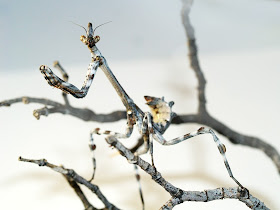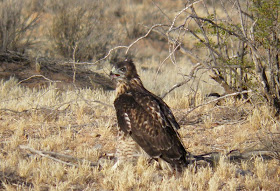 |
| The nesting cavity is in the left arm of the right Saguaro. The female Kestrel is sitting in the dead Palo Verde on the left |
There is another raptor family that is even closer to my heart than the Red-tail Hawks: our backyard American Kestrels whose nest is only about 50 yards from my studio window. My reluctance to write about them earlier stems from a sad experience a couple of years ago when not only the chicks from the same nesting location fell victim to ravens, but the valiant, protective little male was also killed when he flew head-first into a cholla cactus. But the old Flicker cavity with the slightly enlarged entrance attracted a pair of Kestrels again, and maybe it's even the female that nested here before.
 |
| Photo by Ned Harris |
During their 'Honeymoon' in late January, the pair was very noisy and obvious. When we were having breakfast on the patio we were constantly treated to the females high-pitched keerrr-keerrr and the males sharper kick-kick-kick....
They had their favorite spot close to the Saguaro cave on an old, dead Palo Verde. We leave dead trees to decay naturally and a lot of birds really appreciate these easy perches with great overview. Often, there is a quail, a dove and a thrasher already in line for this prime spot when the kestrel leaves for a hunting trip.
By mid February, the female spent most of her time close to the nest leaving the hunting to the male. They were still mating often and she didn't seem to be incubating any eggs yet. During my studies in the Arctic I learned that female Terns that are pregnant with eggs cannot fish - the high impact dive into the water would jeopardize the eggs. So the male faithfully feeds her for a couple of weeks.
 |
| He just presented her with a lizard |
It seems that our Kestrels followed similar precautions. It got much more quiet when she actually began to sit on the eggs (as far as I know raptors start incubation as soon as the first egg is laid, which accounts for the size-differences of the chicks.)
The Gila Woodpeckers who had moved into a hole in the same saguaro were taking turns incubating, but the Kestrel female did the job alone. She regularly escaped the narrow cave to preen on her perch. She now had obvious brood patches on her breast where the feathers were thinned out to allow optimal heat transfer from her body to the eggs.
While she was incubating, she also ate the lizards that the male delivered on her perch. Eventually, this changed and she took the prey from him to carry it into the nest. From the way her tail was sticking up awkwardly in the entrance hole I guess she was now feeding the prey bite by bite to small chicks in the cave.. Fussy eaters: she had to carry the lizard tails away after the meal. Later in March, I saw the male trying to bring a big lizard into the hole himself, but he didn't succeed and carried it into a nearby tree where the female eventually joined him to retrieve it.
By mid April the female was also hunting herself. From then on the diet also included small birds. Although this pair is usually very quiet around the nest, we witnessed some drama when the male pursued the Red-tail hawk in the air - dive-bombing him for over 15 minutes.

Another time a mob of thrashers, doves, cactus wrens, gila woodpeckers and verdins congregated in an Ironwood tree and the male kestrel was diving very low....I thought they were mobbing a ground predator, but it turned out that a huge Cooper's Hawk had landed on the lowest branches of the tree.
And of course there are the ravens who are now attracted to the saguaros not only to steal nestlings but also to nosh sweat nectar from the flowers. I must admit that I have sicked the dogs on the ravens now numerous times and the smart bird seem to learn that it's unpleasant to visit.
An unexpected disturbance happened when a hot air balloon, out of gas and overloaded, made an emergency landing on our land close to the nest. After that the kestrels lay low for the rest of the day, but by late afternoon the urge to feed the hungry brood was stronger than their fear. While raptors are known to leave a nest with eggs after a disturbance, the bond seems much stronger when the chicks are hatched.
All through April, the kestrel chicks have been growing in the narrow cave. They are finally old enough to eliminate white sprays of uric acid out of the entrance, so the ground now bears the white splatter characteristic for all raptor rookeries. Sometimes I can see a big black eye surrounded by white fluff peering out of the dark, and at other times there is a wild tangle of short tails and stubby wings visible. They are getting big for their nursery!
Looking through my pictures I notice a steady improvement over the three months of observation. This has nothing to do with my skills or my camera's capacity. It's that the birds have become much more trusting over time, so I can now approach the nesting saguaro as closely as 15 feet while the female is calmly watching.
 Nearly too cool for the Desert Iguana who seems to enjoy the triple digits more than all other reptiles around here. I'm still trying to catch one that's climbed up in a creosote bush to feed on leaves or flowers, but they are very fast and careful, trying to get close to a hole in the ground even if they don't quite disappear
Nearly too cool for the Desert Iguana who seems to enjoy the triple digits more than all other reptiles around here. I'm still trying to catch one that's climbed up in a creosote bush to feed on leaves or flowers, but they are very fast and careful, trying to get close to a hole in the ground even if they don't quite disappear

























































